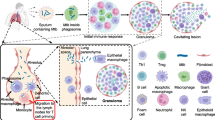Abstract.
The enoyl-acyl carrier protein reductase (ENR) is the last enzyme in the fatty acid elongation cycle. Unlike most enzymes in this essential pathway, ENR displays an unusual diversity among organisms. The growing interest in ENRs is mainly due to the fact that a variety of both synthetic and natural antibacterial compounds are shown to specifically target their activity. The primary anti-tuberculosis drug, isoniazid, and the broadly used antibacterial compound, triclosan, both target this enzyme. In this review, we discuss the diversity of ENRs, and their inhibitors in the light of current research progress.
Similar content being viewed by others
Author information
Authors and Affiliations
Corresponding author
Additional information
Received 3 November 2008; received after revision 5 December 2008; accepted 8 December 2008
Rights and permissions
About this article
Cite this article
Massengo-Tiassé, R.P., Cronan, J.E. Diversity in enoyl-acyl carrier protein reductases. Cell. Mol. Life Sci. 66, 1507–1517 (2009). https://doi.org/10.1007/s00018-009-8704-7
Published:
Issue Date:
DOI: https://doi.org/10.1007/s00018-009-8704-7




